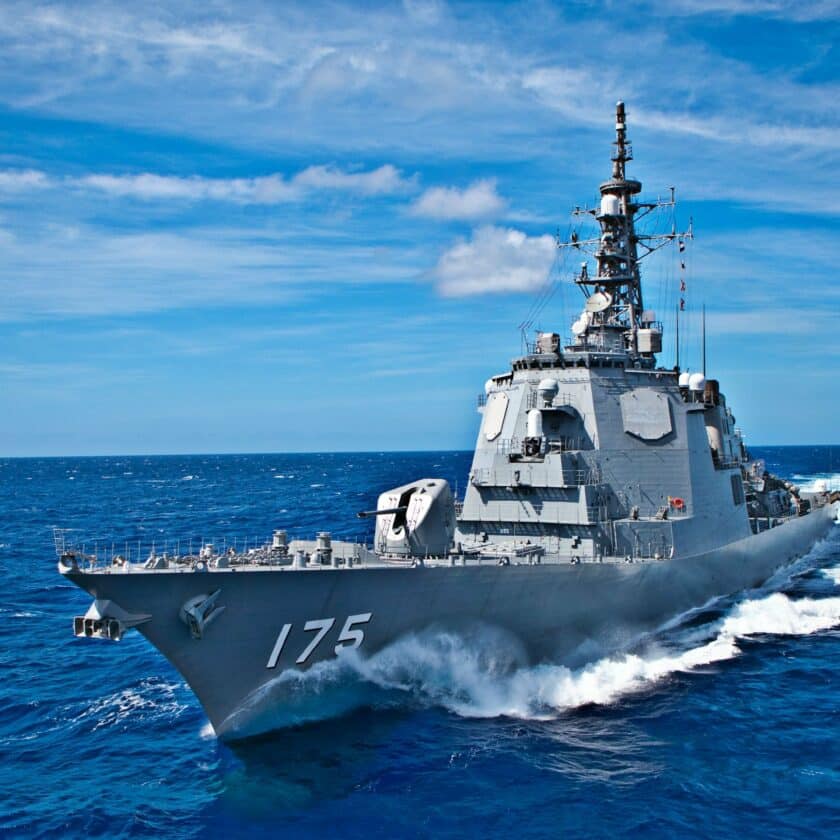This article follows the article “Hobart, Type 52D, Sejong the Great: modern destroyers – Part 1” published on May 24, 2021, which presented the Hobart (Australia), Type 052D/DL (China), Sejong the Grand (South Korea) and Kolkata (India). The second part completes this panel of the eight main classes of Modern Destroyers, with the Kongo class (Japan), Arleigh Burke (United States), Daring (United Kingdom) and 22350M Super Gorshkov (Russia).
Kongo class (Japan, 4 + 2 + 2 units)
The Japanese Naval Self-Defense Forces are considered to be the 3rd most powerfully armed fleet in the world, on par with Russia and yielding only to the US Navy and Chinese naval forces.
And the 4 heavy destroyers of the Kongo class, in addition to the 4 heavy anti-aircraft destroyers of the Atago and Maya classes, contribute a lot to this position, alongside the approximately 20 sSoryu and Taigei-class ocean attack submarines.
Derived from the American Arleigh Burke-class destroyers shown below, the Kongo-class destroyers were the first non-American ships to be fitted with the famous SPY-1 radar and the AEGIS system, which until now only equipped the Ticonderoga cruisers and the first Arleigh Burkes.
The construction of the 4 Kongo began in 1990 and was completed in 1998, in order to replace the Amatsukaze class destroyers still equipped with the Tartar system and SM1-MR missiles, while the risk of having to face Soviet supersonic bombers Tu -22M3 Backfire-C and their AS-4 Kelt supersonic anti-ship missiles were taken more and more seriously by the Japanese Navy in the late 80s when the decision was made to build these ships.

161 m long for a loaded tonnage of 10.000 tons, the Kongo carry, like the American Burke Flight I, 90 Mk41 vertical silos to implement SM-2 anti-aircraft missiles or ASROC anti-submarine missiles, as well as SM3 anti-ballistic missiles since the 2003 modernization.
A 127 mm gun, 8 Harpoon anti-ship missiles, 2 Phalanx CIWS and 2 triple torpedo tubes complete the armament. Like the Burkes, the Kongo also have an SQS-53C hull sonar system, and implement an SH-60J naval helicopter to reinforce their ASM capabilities.
Longer than 4 meters, the 2 Atago class destroyers were built from 2004 to 2008 to replace the Tashikaze class destroyers, also equipped with the Tartar system. Unlike the more versatile Kongos, the Atagos were specialized in anti-aircraft and anti-missile warfare, and the protection of the Japanese coasts against North Korean ballistic missiles.
For this, the ships were equipped with the SPY-1D (V) radar, an evolution of the SPY-1D which equips the Kongo, but presenting much better performance near the coast, in order to allow the ships to better protect the Japanese coast. .
The 2 ships also natively carry the SM3 anti-ballistic missile, and have 96 vertical silos and not 90 like the Kongos. If it has a hangar and a platform to implement an ASM SH-60J helicopter, it is rarely embarked.
Both Maya class destroyers were built between 2017 and 2021 to replace the Hatakaze-class destroyers, the last ships of the Japanese naval forces to use the Tartar system. Derived from the Atago, the Maya incorporate the main characteristics, including the SPY-1D(V) radar and the 96 vertical silos.
More modern, they can implement the SM-6 missile capable of striking ballistic missiles as well as ships and land targets. On the other hand, the two ships have a radically different propulsion architecture from that of the Kongo and Atago based on 4 LM-2500 gas turbines.
The Maya, for their part, implement a Gas-electric hybrid propulsion known as COGLAG (Combined Gas turbine-eLectric And Gas), allowing them to have a much greater electrical power than their predecessors, and therefore providing them with significant scalability. to accommodate, in the future, directed energy weapon systems, or a Rail Gun electric cannon.
Arleigh Burke Class (United States, 75 units +)
At the end of the 60s, the destroyer was a surface ship format that was no longer very favored by US Navy planners, who then favored the construction of guided missile cruisers, some of which were nuclear powered. like the Virginia, and very successful classes of frigates, with the Knox followed by the O/H Perry. In fact, from 1970 to the mid-80s, the US Navy only launched the construction of 35 destroyers, 31 of the Spruance class, and 4 of the Kidd class.

The rest of this article is for subscribers only
The Classic subscriptions provide access to
all articles without advertising, starting at € 1,99.
Newsletter subscription
Register for the Meta-Defense Newsletter to receive the
latest fashion articles daily or weekly


[…] 240 combat aircraft including 150 F-15Js, and a strong naval force of 20 submarines, 36 destroyers (including 8 AEGIS), 8 frigates (22 in the end) as well as 2 light aircraft carriers, these were not […]
[…] of the American anti-aircraft and anti-missile technology AEGIS. But unlike the 4 Kongo-class destroyers, as well as the two Atago-class destroyers and the two Maya-class destroyers which […]